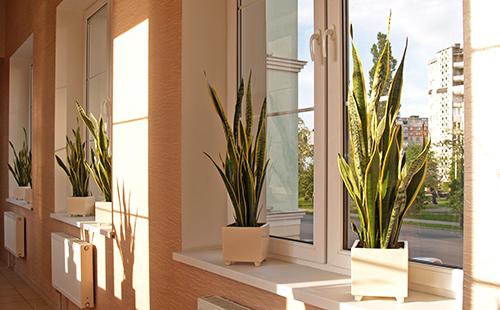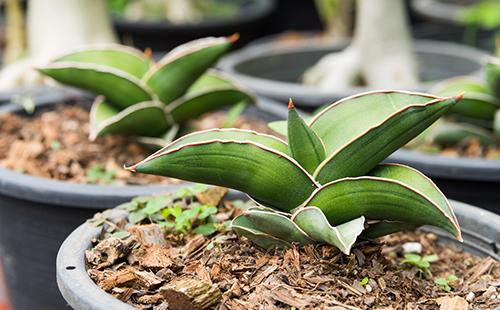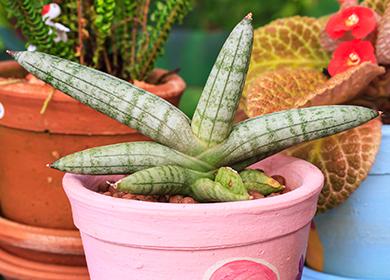The content of the article
The most famous plant among the inhabitants is "pike tail", "mother-in-law's tongue", "snake skin". Sansevieria is an evergreen perennial. It got its name in honor of the Italian prince Sanseviero (XVIII century), who patronized the science of flora. The plant can be found in Madagascar, India, Indonesia, Africa. It feels great in the conditions of the tropics and subtropics, can grow on stony and dry soils. Until now, in Uganda, Kenya, scientists are looking for new species. Sansevieria does not grow in cold regions.
Varieties: which one to choose
Where can I buy Sansevier? The genus of the plant includes about 69 species. Most varieties are derived from Sansevieria three-lane. Each of them has its own characteristics. Among the variety, you can choose an undemanding plant care for home decor. There are plants that are rarely found on sale, as they are not popular for certain reasons. For example, the variety "Nelson", which is growing slowly. Features of the most common flower varieties are shown in the table.
Table - Popular Varieties of Snake Skin
| View name | Features |
|---|---|
| "Three-way" | - The xiphoid form; - pointed ends; - green leaves with transverse stripes of a darker shade; - light green small flowers with a pleasant aroma |
| "Cylindrical" | - Upright tubular leaves of dark green color; - leaves broad at the base with a tip at the end; - cream flowers can sometimes have a red tint |
| Pickaxe | - Two or three sheets form a socket; - green background with the same or gray spots; - red or brown edging |
| Liberian | - Up to six leaves in the outlet; - a dark green background with lighter stripes, strokes with blurry edges; - a red line may go along the edges; - flowers with a pungent aroma |
| "Graceful" | - Leaves with pointed ends; - gray-green background with brown-beige, light gray stripes |
| Dunery | - 10-20 leaves of a linear-lanceolate form in one outlet; - a bright green background with darker, slightly pronounced transverse stripes; - the scent of flowers is similar to the smell of lilac |
| Hyacinth | - Lanceolate, narrowed at the base of the leaves in a bunch of two to four pieces; - a bright or dark green background with lighter transverse strokes in the form of the letter W; - small flowers have a pleasant aroma |
| "Big" | - Wide leaves of intense green color with darker stripes |
| Hanni | - In the outlet 5-15 leaves with the ends bent outward |
| Golden Hanni | - Dark green background; - wide gold stripes at the edges |
| Silver Hanni | - Bright green and white stripes on the leaves |
| Moonshine | - Gray-green or silver leaves with blurred transverse stripes; - edges with a dark green border |
| Laurenti | - A wide rim of bright yellow or white colors goes along the edge of the sheet |
Caring for Sansevieria: Key Points
Although the plant is unpretentious and can be kept even in fairly harsh conditions, growing a flower, you must adhere to three basic rules:
- provide regular watering;
- put the pot in a place where there is good lighting;
- planting, feeding on schedule.
Lighting
The plant does not die in low light, but you do not need to constantly keep it in the back of the room. It will be healthy, beautiful with a lot of natural and artificial light. If the plant is located on the south side, on hot days in summer it will need to be shaded.
Variegated varieties need special conditions. If the coloring is represented in a large amount of yellow, then the “mother-in-law's tongue” should be in a poorly lit place. Otherwise, variegated leaves can become ordinary green. An excellent solution would be an intermediate position in relation to the window.
Temperature
How to care for a sansevier? Sansevieria cylinder feels comfortable in different temperature conditions. But the most favorable conditions are 16-20 ° C at night and 21-28 ° C during the day. At the same time, the cultivation of sansevieria at home involves “street” conditions. From spring, the plant can be taken out to the garden, to the balcony, to the loggia.
In winter, the leaves should not come in contact with a cold window. When airing, the plant is removed from the windowsill or from a place where frosty air can reach. It is better if in winter the room will be 15 ° C.

Humidity
The level of humidity does not play a big role. The leaves are wiped with a wet rag, when they become dirty, dust appears on them. The plant can be kept in a dry climate, so there is no need for frequent spraying.
Watering
Sansevieria should be watered regularly, but in moderation. It should be remembered that this is a succulent plant that has a supply of water in the tissues. The earth must have time to dry out to a great depth. Better pour water on top of the pot.
The frequency of watering depends on the conditions of detention. In the spring and summer periods, “mother-in-law's tongue” is watered once every five to seven days. In autumn and winter, the frequency is once every two weeks. Reserved room temperature water is used.
Top dressing
In winter, the plant does not need additional nutrition. Fertilizers are used from the beginning of spring to the end of autumn. It can be universal mineral complexes, recharge, which are intended for cacti, succulents.
From May to September, you can feed the plant once every 14 days. Fertilizers are added once a month and “mother-in-law's tongue” does not suffer from this if it is in a darkened warm place. It is convenient to use liquid type products.
Transfer
Home care for sansevieria after purchase does not imply an early transplant, especially if it is a young plant.The procedure may be needed only after two to three years. It is recommended to transplant the plant during the period of active growth - the spring months or the beginning of summer. The main sign that the "mother-in-law's tongue" needs to be changed habitat are protruding roots. They become crowded in a pot, and they appear on the surface.
The roots of sansevieria grow in width, so it is better to choose not a high, but a wide container with thick walls. Be sure to prepare the drainage, which should occupy one fourth of the entire pot. Small crushed stone, broken shards, expanded clay, small pieces of coal are used for it.
The plant may be contained in different soil. You can mix sheet earth and turf. Peat, humus, sand, vermiculite, perlite are added. A ready-made environment is light soil that can dry quickly. Suitable and store products, which are designed for cacti and succulents.

Breeding
There are several proven methods for propagating sansevieria. To grow a healthy and beautiful plant is not difficult if you follow simple rules.
Rhizome division
Features. Having decided to plant the mother-in-law's tongue, it is necessary to carry out the procedure in the spring. By winter, the plant will be able to get stronger. This method allows you to save the background, stripes, yellow border on the leaves. It can be used both for plain and variegated species.
Action algorithm
- With a sharp knife we cut the root into several parts, each of which should have a growth point.
- We plant in separate containers.
- Pots leave in a warm and bright place.
- We provide moderate watering until the "kids" take root.
Cuttings
Features. A popular method, as it is easy to use. Reproduction of sansevieria by cuttings occurs in the first month of spring. It is not used for variegated species, since the leaves acquire one color - green.
Action algorithm
- We take a sheet and divide it into parts, each of which should be 4-5 cm long.
- Keep a little in the air and place the lower end in the sand, maintaining an angle of 45 ° C.
- Cover with a plastic bag, a bottle.
- We leave in a warm place with bright, diffused light.
- After 30-40 days and after the buds have appeared, we transplant the plant into the ground.
Seed use
Features. Since the tongue flower of the mother-in-law blooms quite rarely at home, the seeds are not often used. In stores, finished material is also difficult to get.
Action algorithm
- We stick the seeds in the wet sand.
- Cover with a plastic container.
- We place in a warm, bright place.
- Water through the pan.
- When the seedlings grow, we dive them.
- When the sprouts reach a height of 7-8 cm, transplanted into the ground.

Do I wait for flowers
A plant at home blooms very rarely. During the flowering period, the "pike tail" releases a long arrow, which can reach a height of 1 m. Small flowers of white-green or white-red colors are often located on it. In their form, they look like a lily.
Flowers ripen slowly, exude a pleasant aroma. In most cases, they begin to bloom in the evening.The plant can bloom at any time of the year, but most often it occurs in spring and summer. Flowers from one outlet appear once in a lifetime of a pike tail. You can observe the beauty and enjoy the exquisite aroma for five to seven days.
Why leaves deteriorate
After a certain amount of time, under the influence of external factors, the leaves of sansevieria change their color, deteriorate. Here are the unpleasant manifestations that occur most often.
- Leaves fade. If sansevieria has sluggish leaves, this symptom may indicate an excess of moisture. To avoid this phenomenon, it is necessary to establish a mode of moderate watering. If the roots are rotted, then the plant needs to be transplanted using healthy leaves.
- Leaves curl. This problem occurs when a mealybug is exposed. You can get rid of the pest by removing it manually, treating the affected areas with Karbofos.
- Stains on the leaves. Dark formations appear due to a lack of light, so the plant needs to be rearranged to another place with better lighting. This method will help if the leaves are pale. But spots of brown, yellow appear from excessive watering, as a result of exposure to fungus. The solution is to reduce watering, use antifungal agents.
- The tips of the leaves are dry. The problem appears if the temperature is not observed. Damage often occurs in the winter. The leaves also turn yellow from an excess of cold air, especially when the flower is on the windowsill.
Main enemies
The gardener may be the very first and main pest. Based on reviews, improper care can provoke diseases of the leaves and root system. In order not to ruin a beautiful and useful plant, you should competently approach its cultivation, observing the basic rules.
Dangerous insects
The pike tail can be attacked by pests. The problem becomes serious and leads to the death of the plant only if appropriate measures have not been taken. You can get rid of insects with improvised means or special products. How to effectively defeat enemies is displayed in the table.
Table - Pests of “snake skin” and ways to combat them
| Pest name | Features | Methods of struggle |
|---|---|---|
| Spider mite | - The leaves turn pale yellow; - there are solid white spots; - provokes the death of leaves | - Wipe with a damp sponge (with a small lesion); - spray “Actellik” (with a strong defeat) |
| Thrips | - Colonies settle on the underside of leaves; - light small spots appear on top | - Spray with insecticides |
| Mealybug | - It is located in the socket; - sucks juice; - provokes the death of leaves | - Choose insects with your hands; - wipe the plant with a sponge moistened in water; - treat with “Karbofos” (with severe defeat) |
Frequent ailments
Most often, sansevieria is affected by anthracnose. Recognizing the disease is quite simple. The main symptom is the appearance of small brown spots. The disease is characterized by a slow course. Gradually, spots may increase in size. In the middle they turn white, a yellow or green shell forms. If you do not take protective measures, then the leaves dry.
Sansevieria in India is used in folk medicine. They know well how to care for their mother-in-law's tongue. Leaves are also used as raw materials in the production of fiber, which is characterized by high strength, not affected by sea water. Ropes, mats are made from it. In Ceylon, a plant is used to create hedges.

